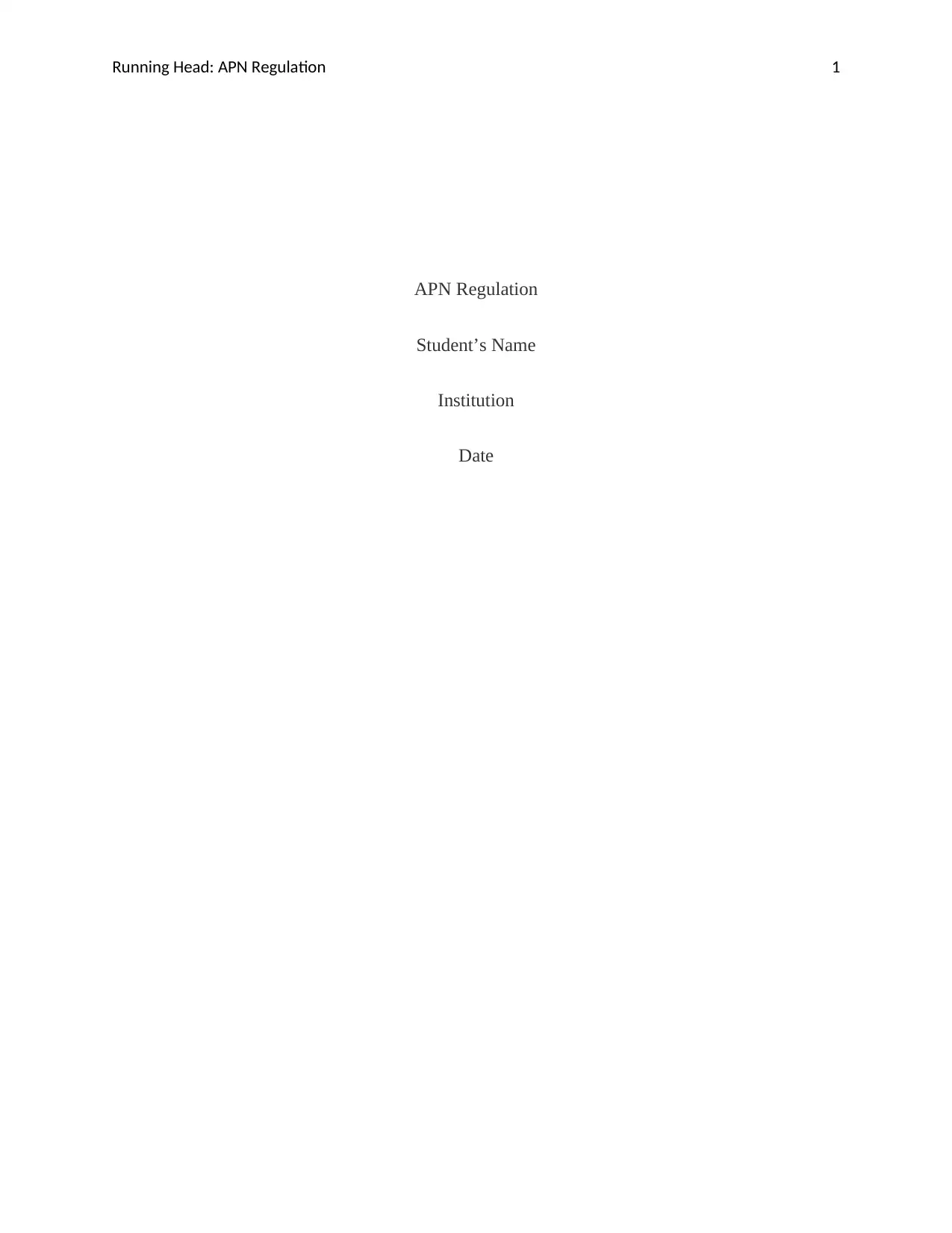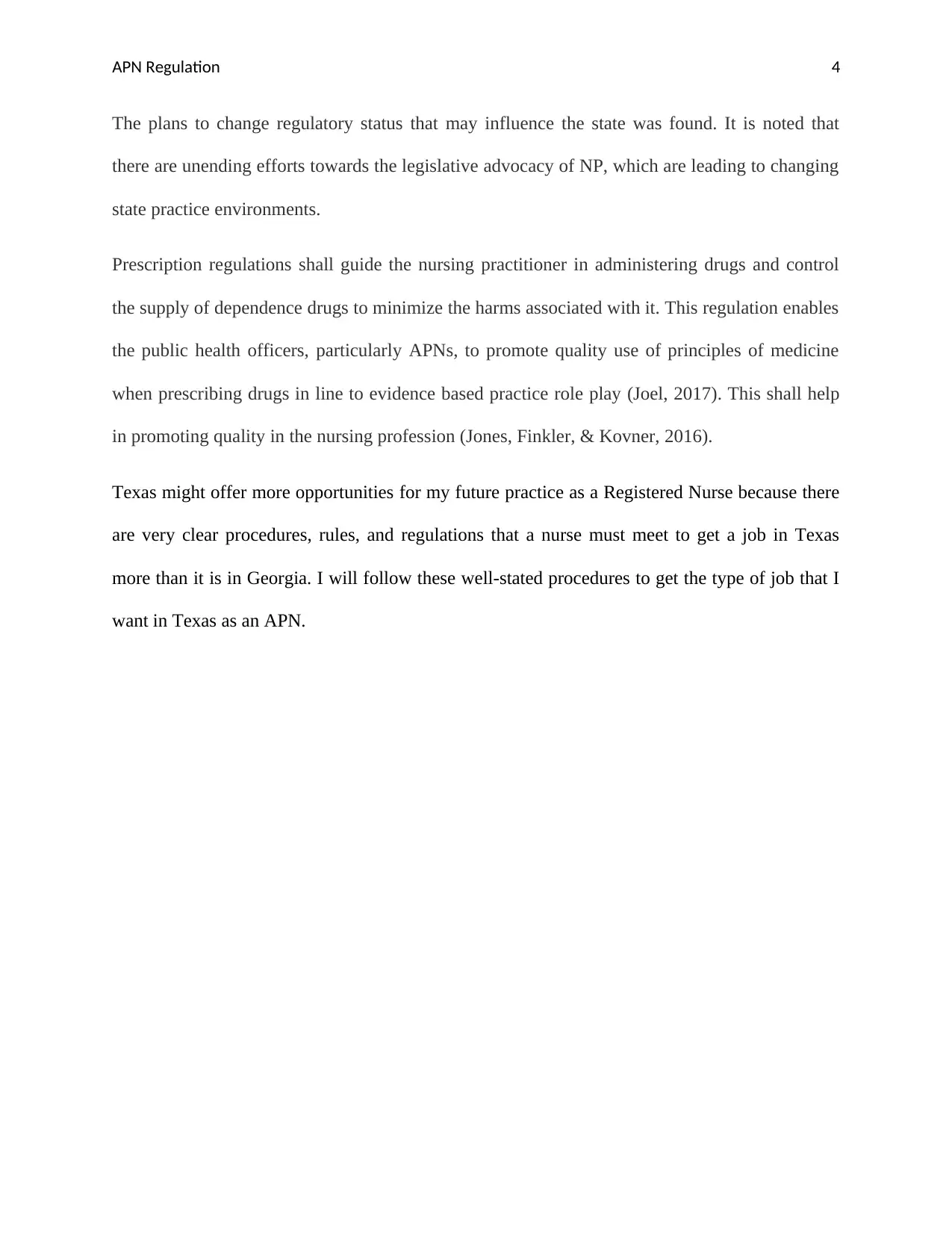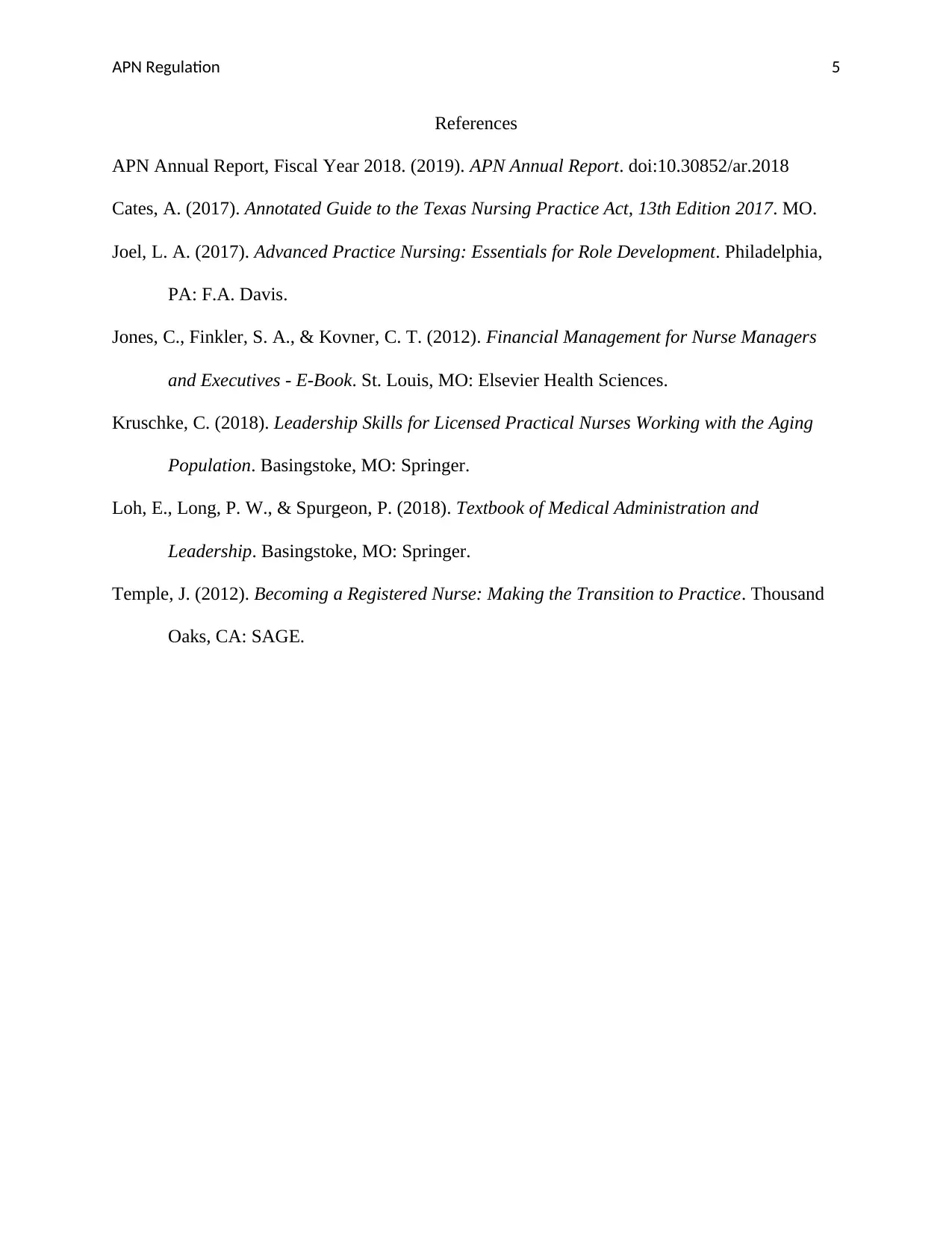Detailed Comparison of APN Regulations: Texas and Georgia
VerifiedAdded on 2022/08/17
|5
|1060
|18
Essay
AI Summary
This paper provides a comparative analysis of Adult Nurse Practitioner (ANP) regulations in Texas and Georgia. It defines ANPs and their role in providing primary care to adult patients, emphasizing the importance of state-specific regulations. The paper contrasts prescriptive authority requirements, the governing boards, and practice acts in both states. In Texas, prescriptive authority involves a separate application and registration with the DEA and the public safety department, while in Georgia, it requires a protocol agreement with a supervising physician. The author discusses the pros and cons of each state's regulations, highlighting the potential impact on patient care quality. The paper also mentions efforts to change regulatory statuses and how these regulations influence the nursing profession, concluding with the author's preference for Texas due to its clear procedures and regulations.

Running Head: APN Regulation 1
APN Regulation
Student’s Name
Institution
Date
APN Regulation
Student’s Name
Institution
Date
Paraphrase This Document
Need a fresh take? Get an instant paraphrase of this document with our AI Paraphraser

APN Regulation 2
APN REGULATION
Provide a Definition statement regarding the issue that you are discussing
In this paper, the ANP regulations of Texas and the state of Georgia shall be discussed. An ANP
is an Adult Nurse Practitioner who is fully educated and skilled about how to offer quality
primary care to an adult patient, those aged 12 and above. They are guided by specific
regulations in every state that determine the way they should carry out their activities and what a
particular state expects of them. The main role of an ANP is offering preventive care to patients
and manage chronic and acute health issues (Temple, 2015). The regulations in the two states
shall be compared.
In Texas, the prescriptive authority is granted through a separate application written ‘prescriptive
delegation’ by the supervising physician. To get prescriptive authority also, the supervising
physician must also register DEA for controlled substances and register with the public safety
department in Texas (Cates, 2017).In Georgia, prescriptive authority requires a ‘protocol
agreement’ with the supervising physician. The Board of Nursing in Texas is the Texas Board of
Nursing, while in Georgia is the Georgia Board of Nursing. The practice Act in Texas is the
Texas Nursing Practice Act, while in Georgia, it is the Georgia Nurse Practice Act. About details
and resources (Kruschke, 2018). Texas has currently eliminated the on-site physician supervision
requirement while in Georgia, Registered nurses get the prescriptive authority for practice by the
Georgia Composite Medical Board
In both states, full practice regulation requires all nurses and practitioners to keenly evaluate
patients, diagnosing , interpreting and ordering diagnostic tests, managing and initiating the
APN REGULATION
Provide a Definition statement regarding the issue that you are discussing
In this paper, the ANP regulations of Texas and the state of Georgia shall be discussed. An ANP
is an Adult Nurse Practitioner who is fully educated and skilled about how to offer quality
primary care to an adult patient, those aged 12 and above. They are guided by specific
regulations in every state that determine the way they should carry out their activities and what a
particular state expects of them. The main role of an ANP is offering preventive care to patients
and manage chronic and acute health issues (Temple, 2015). The regulations in the two states
shall be compared.
In Texas, the prescriptive authority is granted through a separate application written ‘prescriptive
delegation’ by the supervising physician. To get prescriptive authority also, the supervising
physician must also register DEA for controlled substances and register with the public safety
department in Texas (Cates, 2017).In Georgia, prescriptive authority requires a ‘protocol
agreement’ with the supervising physician. The Board of Nursing in Texas is the Texas Board of
Nursing, while in Georgia is the Georgia Board of Nursing. The practice Act in Texas is the
Texas Nursing Practice Act, while in Georgia, it is the Georgia Nurse Practice Act. About details
and resources (Kruschke, 2018). Texas has currently eliminated the on-site physician supervision
requirement while in Georgia, Registered nurses get the prescriptive authority for practice by the
Georgia Composite Medical Board
In both states, full practice regulation requires all nurses and practitioners to keenly evaluate
patients, diagnosing , interpreting and ordering diagnostic tests, managing and initiating the

APN Regulation 3
necessary patient treatments and use the exclusive licensure from the state Nursing Board to
prescribe medications (Loh, Long, & Spurgeon, 2018). Reduced practice regulation is that the
nurse practitioners should engage in at least a single element of NP practice. According to the
law of the state, there should be a regulated collaborative agreement between an NP and an
outside health discipline to allow the NP to offer patient care, limit the setting/the scope or
provide more elements of NP practice. Restricted practice regulations are that the state law for
practice and licensure restricts the nurse practitioner where they should at least engage in one NP
practice element. For the NP to provide patient care, the state requires an outside health
discipline to carry out supervision, delegation, and management of teams ("APN Annual Report,
Fiscal Year 2018," 2019)
From my interpretation about the regulations, the pros in Texas is that patients can get the right
prescriptions by the nurses because permission for any prescription is guaranteed through
meeting particular requirements by every APN to show how competent they are in the field
where they should apply and register with the public safety department in Texas. This means that
a proper prescription is done through a controlled substance. The disadvantage of this regulation
is that it is a very long and tedious process, very costly for it requires resources as well as time.
This regulation may positively affect the quality of service offered to patients by practitioners
because the procedures offered lead towards the proper administration of medications.
In Georgia, the pros of the prescriptive regulations are that it is not a long time process because
an agreement is made between the nurse and the supervising physician. The disadvantage of this
regulation is that there are no specific set standards by the state, meaning there is no set rule to
equate all the prescription standards in Georgia, an issue that may arise public safety issues. This
may negatively influence quality service practices in hospitals in Georgia by APNs.
necessary patient treatments and use the exclusive licensure from the state Nursing Board to
prescribe medications (Loh, Long, & Spurgeon, 2018). Reduced practice regulation is that the
nurse practitioners should engage in at least a single element of NP practice. According to the
law of the state, there should be a regulated collaborative agreement between an NP and an
outside health discipline to allow the NP to offer patient care, limit the setting/the scope or
provide more elements of NP practice. Restricted practice regulations are that the state law for
practice and licensure restricts the nurse practitioner where they should at least engage in one NP
practice element. For the NP to provide patient care, the state requires an outside health
discipline to carry out supervision, delegation, and management of teams ("APN Annual Report,
Fiscal Year 2018," 2019)
From my interpretation about the regulations, the pros in Texas is that patients can get the right
prescriptions by the nurses because permission for any prescription is guaranteed through
meeting particular requirements by every APN to show how competent they are in the field
where they should apply and register with the public safety department in Texas. This means that
a proper prescription is done through a controlled substance. The disadvantage of this regulation
is that it is a very long and tedious process, very costly for it requires resources as well as time.
This regulation may positively affect the quality of service offered to patients by practitioners
because the procedures offered lead towards the proper administration of medications.
In Georgia, the pros of the prescriptive regulations are that it is not a long time process because
an agreement is made between the nurse and the supervising physician. The disadvantage of this
regulation is that there are no specific set standards by the state, meaning there is no set rule to
equate all the prescription standards in Georgia, an issue that may arise public safety issues. This
may negatively influence quality service practices in hospitals in Georgia by APNs.
⊘ This is a preview!⊘
Do you want full access?
Subscribe today to unlock all pages.

Trusted by 1+ million students worldwide

APN Regulation 4
The plans to change regulatory status that may influence the state was found. It is noted that
there are unending efforts towards the legislative advocacy of NP, which are leading to changing
state practice environments.
Prescription regulations shall guide the nursing practitioner in administering drugs and control
the supply of dependence drugs to minimize the harms associated with it. This regulation enables
the public health officers, particularly APNs, to promote quality use of principles of medicine
when prescribing drugs in line to evidence based practice role play (Joel, 2017). This shall help
in promoting quality in the nursing profession (Jones, Finkler, & Kovner, 2016).
Texas might offer more opportunities for my future practice as a Registered Nurse because there
are very clear procedures, rules, and regulations that a nurse must meet to get a job in Texas
more than it is in Georgia. I will follow these well-stated procedures to get the type of job that I
want in Texas as an APN.
The plans to change regulatory status that may influence the state was found. It is noted that
there are unending efforts towards the legislative advocacy of NP, which are leading to changing
state practice environments.
Prescription regulations shall guide the nursing practitioner in administering drugs and control
the supply of dependence drugs to minimize the harms associated with it. This regulation enables
the public health officers, particularly APNs, to promote quality use of principles of medicine
when prescribing drugs in line to evidence based practice role play (Joel, 2017). This shall help
in promoting quality in the nursing profession (Jones, Finkler, & Kovner, 2016).
Texas might offer more opportunities for my future practice as a Registered Nurse because there
are very clear procedures, rules, and regulations that a nurse must meet to get a job in Texas
more than it is in Georgia. I will follow these well-stated procedures to get the type of job that I
want in Texas as an APN.
Paraphrase This Document
Need a fresh take? Get an instant paraphrase of this document with our AI Paraphraser

APN Regulation 5
References
APN Annual Report, Fiscal Year 2018. (2019). APN Annual Report. doi:10.30852/ar.2018
Cates, A. (2017). Annotated Guide to the Texas Nursing Practice Act, 13th Edition 2017. MO.
Joel, L. A. (2017). Advanced Practice Nursing: Essentials for Role Development. Philadelphia,
PA: F.A. Davis.
Jones, C., Finkler, S. A., & Kovner, C. T. (2012). Financial Management for Nurse Managers
and Executives - E-Book. St. Louis, MO: Elsevier Health Sciences.
Kruschke, C. (2018). Leadership Skills for Licensed Practical Nurses Working with the Aging
Population. Basingstoke, MO: Springer.
Loh, E., Long, P. W., & Spurgeon, P. (2018). Textbook of Medical Administration and
Leadership. Basingstoke, MO: Springer.
Temple, J. (2012). Becoming a Registered Nurse: Making the Transition to Practice. Thousand
Oaks, CA: SAGE.
References
APN Annual Report, Fiscal Year 2018. (2019). APN Annual Report. doi:10.30852/ar.2018
Cates, A. (2017). Annotated Guide to the Texas Nursing Practice Act, 13th Edition 2017. MO.
Joel, L. A. (2017). Advanced Practice Nursing: Essentials for Role Development. Philadelphia,
PA: F.A. Davis.
Jones, C., Finkler, S. A., & Kovner, C. T. (2012). Financial Management for Nurse Managers
and Executives - E-Book. St. Louis, MO: Elsevier Health Sciences.
Kruschke, C. (2018). Leadership Skills for Licensed Practical Nurses Working with the Aging
Population. Basingstoke, MO: Springer.
Loh, E., Long, P. W., & Spurgeon, P. (2018). Textbook of Medical Administration and
Leadership. Basingstoke, MO: Springer.
Temple, J. (2012). Becoming a Registered Nurse: Making the Transition to Practice. Thousand
Oaks, CA: SAGE.
1 out of 5
Related Documents
Your All-in-One AI-Powered Toolkit for Academic Success.
+13062052269
info@desklib.com
Available 24*7 on WhatsApp / Email
![[object Object]](/_next/static/media/star-bottom.7253800d.svg)
Unlock your academic potential
Copyright © 2020–2025 A2Z Services. All Rights Reserved. Developed and managed by ZUCOL.





